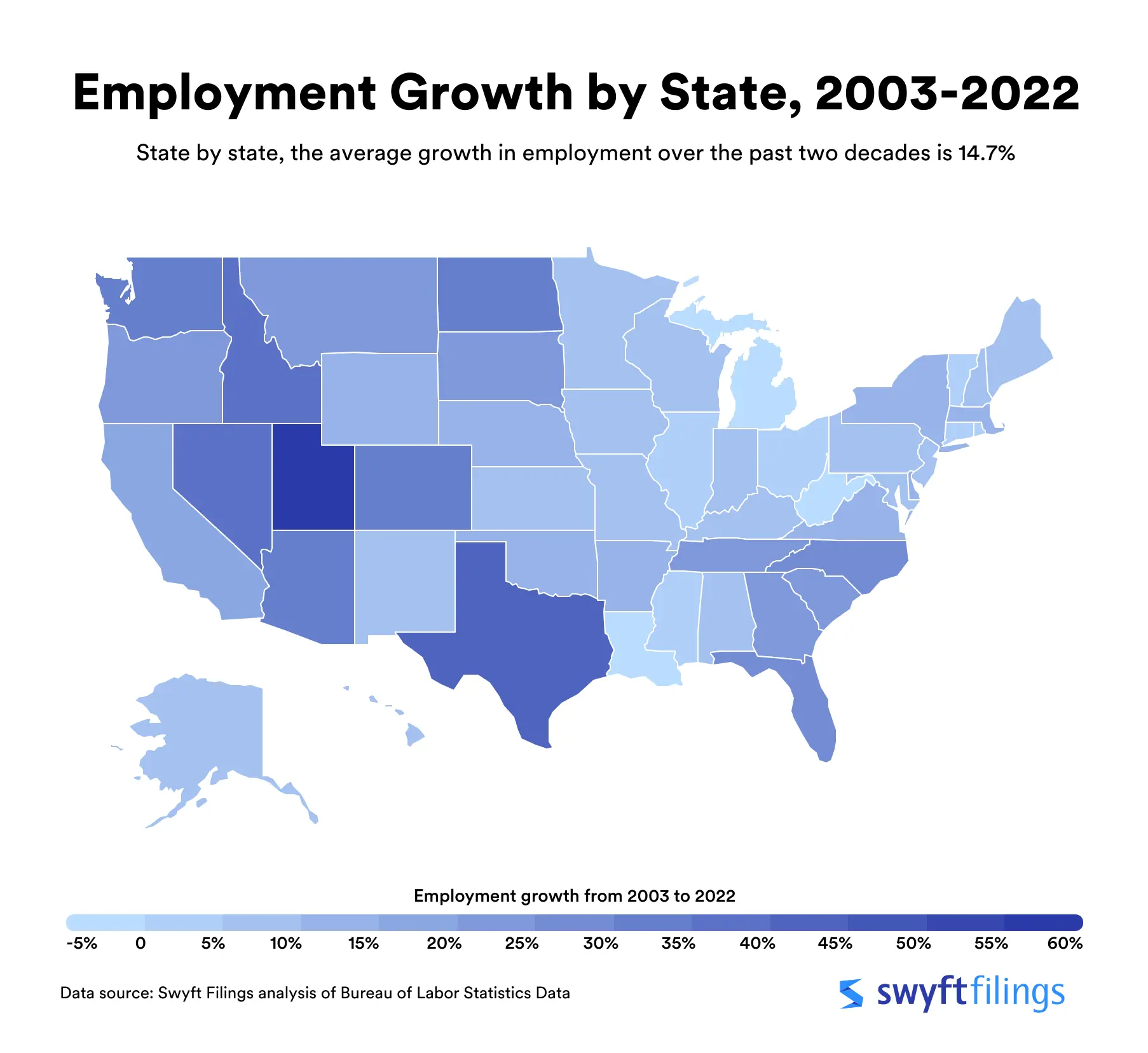States with the Largest Job Increases Over the Last 20 Years
How many jobs has your state's economy added in the last two decades? Relying on the most recent federal data, Swyft Filings ranked all 50 states and Washington D.C.
Over the past 20 years, the U.S. has weathered multiple major financial crises, natural disasters, and dramatic shifts in consumer behaviors. Yet the vast majority of states have managed to grow enough jobs to keep the nation's economy going.
The U.S. has added close to 21 million jobs since 2003, while the population has grown nearly twice that amount. Over that time, more than two dozen states have increased their employment by double-digit percentages.
Swyft Filings used Bureau of Labor Statistics data to rank all 50 states and Washington D.C. by the percentage change in jobs from the second quarter (Q2) 2003 to Q2 2022, breaking any ties according to which state had more overall job gains. For additional context about the labor force and earnings, statistics were also gathered from BLS data on average weekly wages, unemployment, and labor force participation, and state population information from Census Bureau data.

The second quarter of 2022 marked the point at which most states had recovered all of the jobs lost during the COVID-19 pandemic—the biggest shock to the U.S. workforce and economy since the 2007-2008 financial crisis. Some states have seen high-wage jobs grow more quickly than others over the last two years, including North Carolina, Florida, and Texas, according to credit rating agency Fitch Ratings.
Over the two decades studied for this ranking, workers 55 and older became an increasing share of the national workforce, and a far larger proportion than younger workers. In fact, roughly all of the employment growth from 2000 to 2020 was driven by workers 60 years and older, according to the Federal Reserve Bank of St. Louis.
However, the COVID-19 pandemic and the bullish stock market of 2020-2021 pushed many older workers to retire or depart the workforce. According to a study from the Schwartz Center for Economic Policy Analysis, the pandemic added more than one million Americans to the retired population—but retirement was often preceded by a period of unemployment, meaning that many may have chosen to retire when they weren’t able to find another job.Older Americans have also suffered the largest share of pandemic-related deaths.
A few states have seen near-stagnant job growth or an overall loss of jobs compared to 20 years ago, including West Virginia, Louisiana, and Michigan. In West Virginia, economists at West Virginia University point to an overreliance on the coal export industry and low participation rate in the workforce as forces holding back economic growth. Only 1 in 2 adults in the state are working or looking for work.
Continue reading to see how states stack up regarding job increases over the last two decades.
51. West Virginia
Employment, Q2 2022: 672,100 (-2.0% change since Q2 2003)
Population, 2022: 1.8 million (-2.0% change since 2003)
Average weekly wages, Q2 2022: $1,013 (+76.8% change since Q2 2003)
Unemployment rate, June 2022: 3.6% (down from 6.7%, June 2003)
Labor force participation rate, 2022: 55.2% (down from 55.3%, 2003
It can take as little as 10 minutes to start an LLC online with Swyft Filings. Our experienced business specialists can help you save time and money while forming your LLC.
50. Michigan
Employment, Q2 2022: 4.3 million (-1.7% change since Q2 2003)
Population, 2022: 10.0 million (-0.1% change since 2003)
Average weekly wages, Q2 2022: $1,183 (+62.5% change since Q2 2003)
Unemployment rate, June 2022: 4.3% (down from 7.4%, June 2003)
Labor force participation rate, 2022: 60.1% (down from 65.8%, 2003)
49. Louisiana
Employment, Q2 2022: 1.8 million (-1.6% change since Q2 2003)
Population, 2022: 4.6 million (+1.5% change since 2003)
Average weekly wages, Q2 2022: $1,067 (+84.3% change since Q2 2003)
Unemployment rate, June 2022: 3.8% (down from 6.7%, June 2003)
Labor force participation rate, 2022: 59.0% (down from 61.0%, 2003)
48. Vermont
Employment, Q2 2022: 297,700 (0.0% change since Q2 2003)
Population, 2022: 0.6 million (+4.7% change since 2003)
Average weekly wages, Q2 2022: $1,135 (+86.4% change since Q2 2003)
Unemployment rate, June 2022: 2.2% (down from 4.5%, June 2003)
Labor force participation rate, 2022: 61.6% (down from 70.9%, 2003)
47. Connecticut
Employment, Q2 2022: 1.7 million (+0.1% change since Q2 2003)
Population, 2022: 3.6 million (+4.1% change since 2003)
Average weekly wages, Q2 2022: $1,458 (66.8% change since Q2 2003)
Unemployment rate, June 2022: 4.0% (down from 5.6%, June 2003)
Labor force participation rate, 2022: 64.6% (down from 67.4%, 2003)
46. Ohio
Employment, Q2 2022: 5.4 million (+1.0% change since Q2 2003)
Population, 2022: 11.8 (+2.8% change since 2003)
Average weekly wages, Q2 2022: $1,127 (72.3% change since Q2 2003)
Unemployment rate, June 2022: 3.9% (down from 6.4%, June 2003)
Labor force participation rate, 2022: 62.0% (down from 67.2%, 2003)
Ensure you hit all of your filing deadlines, remain compliant, and maintain your privacy with the support of our registered agent services.
45. Rhode Island
Employment, Q2 2022: 488,600 (+1.3% change since Q2 2003)
Population, 2022: 1.1 million (+2.1% change since 2003)
Average weekly wages, Q2 2022: $1,227 (+82.9% change since Q2 2003)
Unemployment rate, June 2022: 2.7% (down from 5.6%, June 2003)
Labor force participation rate, 2022: 63.4% (down from 67.3%, 2003)
44. Illinois
Employment, Q2 2022: 6.0 million (+3.2% change since Q2 2003)
Population, 2022: 12.6 million (+0.2% change since 2003)
Average weekly wages, Q2 2022: $1,325 (76.4% change since Q2 2003)
Unemployment rate, June 2022: 4.5% (down from 6.8%, June 2003)
Labor force participation rate, 2022: 64.6% (up from 66.4%, 2003)
43. Mississippi
Employment, Q2 2022: 1.1 million (+3.8% change since Q2 2003)
Population, 2022: 2.9 million (+2.5% change since 2003)
Average weekly wages, Q2 2022: $887 (+70.2% change since Q2 2003)
Unemployment rate, June 2022: 3.8% (down from 6.3%, June 2003)
Labor force participation rate, 2022: 55.5% (down from 61.6%, 2003)
42. Maine
Employment, Q2 2022: 637,600 (+5.3% change since Q2 2003)
Population, 2022: 1.4 million (+6.0% change since 2003)
Average weekly wages, Q2 2022: $1,086 (90.9% change since Q2 2003)
Unemployment rate, June 2022: 3.0% (down from 5.3%, June 2003)
Labor force participation rate, 2022: 59.0% (down from 66.7%, 2003)
41. Wisconsin
Employment, Q2 2022: 2.9 million (+5.7% change since Q2 2003)
Population, 2022: 5.9 million (+7.5% change since 2003)
Average weekly wages, Q2 2022: $1,097 (+74.7% change since Q2 2003)
Unemployment rate, June 2022: 2.9% (down from 5.8%, June 2003)
Labor force participation rate, 2022: 66.4% (Up/down from 72.4%, 2003)
40. Kansas
Employment, Q2 2022: 1.4 million (+6.4% change since Q2 2003)
Population, 2022: 2.9 million (+7.9% change since 2003)
Average weekly wages, Q2 2022: $1,039 (+75.8% change since Q2 2003)
Unemployment rate, June 2022: 2.4% (down from 5.7%, June 2003)
Labor force participation rate, 2022: 66.5% (down from 70.6%, 2003)
39. Pennsylvania
Employment, Q2 2022: 5.9 million (+6.4% change since Q2 2003)
Population, 2022: 13.0 million (+4.8% change since 2003)
Average weekly wages, Q2 2022: $1,252 (+81.7% change since Q2 2003)
Unemployment rate, June 2022: 4.5% (down from 5.8%, June 2003)
Labor force participation rate, 2022: 61.7% (down from 64.0%, 2003)
38. Maryland
Employment, Q2 2022: 2.6 million (+6.9% change since Q2 2003)
Population, 2022: 6.2 million (+12.2% change since 2003)
Average weekly wages, Q2 2022: $1,378 (81.1% change since Q2 2003)
Unemployment rate, June 2022: 4.0% (down from 4.0%, June 2003)
Labor force participation rate, 2022: 65.9% (down from 69.4%, 2003)
37. New Jersey
Employment, Q2 2022: 4.2 million (+7.3% change since Q2 2003)
Population, 2022: 9.3 million (7.7% change since 2003)
Average weekly wages, Q2 2022: $1,440 (+69.4% change since Q2 2003)
Unemployment rate, June 2022: 3.9% (down from 6.0%, June 2003)
Labor force participation rate, 2022: 62.9% (down from 66.1%, 2003)
36. Missouri
Employment, Q2 2022: 2.9 million (+7.4% change since Q2 2003)
Population, 2022: 6.2 million (+8.2% change since 2003)
Average weekly wages, Q2 2022: $1,106 (+73.1% change since Q2 2003)
Unemployment rate, June 2022: 2.8% (down from 5.8%, June 2003)
Labor force participation rate, 2022: 63.0% (down from 68.8%, 2003)
35. Hawaii
Employment, Q2 2022: 612,600 (+7.5% change since Q2 2003)
Population, 2022: 1.4 million (+15.1% change since 2003)
Average weekly wages, Q2 2022: $1,152 (+81.4% change since Q2 2003)
Unemployment rate, June 2022: 4.2% (up from 4.2%, June 2003)
Labor force participation rate, 2022: 60.8% (down from 65.5%, 2003)
34. Alaska
Employment, Q2 2022: 329,700 (+7.8% change since Q2 2003)
Population, 2022: 0.7 million (+13.1% change since 2003)
Average weekly wages, Q2 2022: $1,237 (+71.1% change since Q2 2003)
Unemployment rate, June 2022: 4.6% (down from 7.8%, June 2003)
Labor force participation rate, 2022: 66.1% (down from 72.3%, 2003)
Start your business the right way by obtaining your federal tax ID EIN so you can open bank accounts, collect revenue, and hire new employees.
33. Indiana
Employment, Q2 2022: 3.1 million (+8.7% change since Q2 2003)
Population, 2022: 6.8 million (+10.3% change since 2003)
Average weekly wages, Q2 2022: $1,083 (+73.8% change since Q2 2003)
Unemployment rate, June 2022: 2.4% (down from 5.3%, June 2003)
Labor force participation rate, 2022: 63.1% (down from 67.9%, 2003)
32. New Mexico
Employment, Q2 2022: 822,400 (+8.9% change since Q2 2003)
Population, 2022: 2.1 million (+12.6% change since 2003)
Average weekly wages, Q2 2022: $1,040 (+79.6% change since Q2 2003)
Unemployment rate, June 2022: 4.9% (down from 6.0%, June 2003)
Labor force participation rate, 2022: 56.9% (down from 63.3%, 2003)
31. Iowa
Employment, Q2 2022: 1.6 million (+8.9% change since Q2 2003)
Population, 2022: 3.2 million (+8.8% change since 2003)
Average weekly wages, Q2 2022: $1,057 (+84.8% change since Q2 2003)
Unemployment rate, June 2022: 2.6% (down from 4.6%, June 2003)
Labor force participation rate, 2022: 67.8% (down from 71.2%, 2003)
30. Kentucky
Employment, Q2 2022: 1.9 million (+9.2% change since Q2 2003)
Population, 2022: 4.5 million (+9.6% change since 2003)
Average weekly wages, Q2 2022: $1,070 (+76.0% change since Q2 2003)
Unemployment rate, June 2022: 3.7% (down from 6.4%, June 2003)
Labor force participation rate, 2022: 58.1% (down from 62.3%, 2003)
29. New Hampshire
Employment, Q2 2022: 671,900 (+9.3% change since Q2 2003)
Population, 2022: 1.4 million (+9.0% change since 2003)
Average weekly wages, Q2 2022: $1,349 (+94.9% change since Q2 2003)
Unemployment rate, June 2022: 2.0% (down from 4.5%, June 2003)
Labor force participation rate, 2022: 65.6% (down from 71.4%, 2003)
28. Minnesota
Employment, Q2 2022: 2.9 million (+9.3% change since Q2 2003)
Population, 2022: 5.7 million (+13.1% change since 2003)
Average weekly wages, Q2 2022: $1,289 (78.3% change since Q2 2003)
Unemployment rate, June 2022: 1.8% (down from 4.9%, June 2003)
Labor force participation rate, 2022: 68.5% (down from 75.1%, 2003)
27. Alabama
Employment, Q2 2022: 2.0 million (+9.8% change since Q2 2003)
Population, 2022: 5.1 million (+12.7% change since 2003)
Average weekly wages, Q2 2022: $1,069 (+77.6% change since Q2 2003)
Unemployment rate, June 2022: 2.6% (down from 6.1%, June 2003)
Labor force participation rate, 2022: 57.2% (down from 62.3%, 2003)
26. Arkansas
Employment, Q2 2022: 1.2 million (+10.4% change since Q2 2003)
Population, 2022: 2.0 million (+11.8% change since 2003)
Average weekly wages, Q2 2022: $997 (82.6% change since Q2 2003)
Unemployment rate, June 2022: 3.2% (down from 5.9%, June 2003)
Labor force participation rate, 2022: 57.0% (down from 62.0%, 2003)
25. Wyoming
Employment, Q2 2022: 280,600 (+11.0% change since Q2 2003)
Population, 2022: 0.6 million (+15.5% change since 2003)
Average weekly wages, Q2 2022: $1,048 (+86.1% change since Q2 2003)
Unemployment rate, June 2022: 3.1% (down from 4.4% June 2003)
Labor force participation rate, 2022: 63.5% (down from 71.3%, 2003)
24. Nebraska
Employment, Q2 2022: 988,500 (+11.4% change since Q2 2003)
Population, 2022: 2.0 million (+13.2% change since 2003)
Average weekly wages, Q2 2022: $1,060 (+87.6% change since Q2 2003)
Unemployment rate, June 2022: 1.9% (down from 4.0%, June 2003)
Labor force participation rate, 2022: 70.0% (down from 74.0%, 2003)
23. Delaware
Employment, Q2 2022: 456,400 (+11.6% change since Q2 2003)
Population, 2022: 1.0 million (+24.5% change since 2003)
Average weekly wages, Q2 2022: $1,227 (+64.0% change since Q2 2003)
Unemployment rate, June 2022: 4.5% (down from 4.6%, June 2003)
Labor force participation rate, 2022: 61.2% (down from 66.8%, 2003)
22. New York
Employment, Q2 2022: 9.3 million (+11.9% change since Q2 2003)
Population, 2022: 19.7 million (+2.9% change since 2003)
Average weekly wages, Q2 2022: $1,587 (+86.5% change since Q2 2003)
Unemployment rate, June 2022: 4.4% (down from 6.5%, June 2003)
Labor force participation rate, 2022: 60.1% (down from 62.6%, 2003)
21. Massachusetts
Employment, Q2 2022: 3.7 million (+14.2% change since Q2 2003)
Population, 2022: 7.0 million (+8.7% change since 2003)
Average weekly wages, Q2 2022: $1,637 (+92.8% change since Q2 2003)
Unemployment rate, June 2022: 3.7% (down from 5.9%, June 2003)
Labor force participation rate, 2022: 66.0% (down from 68.0%, 2003)
20. Virginia
Employment, Q2 2022: 3.9 million (+14.4% change since Q2 2003)
Population, 2022: 8.7 million (+17.9% change since 2003)
Average weekly wages, Q2 2022: $1,316 (+83.0% change since Q2 2003)
Unemployment rate, June 2022: 2.8% (down from 4.4%, June 2003)
Labor force participation rate, 2022: 63.9% (down from 68.4%, 2003)
19. Washington, D.C.
Employment, Q2 2022: 747,600 (+14.7% change since Q2 2003)
Population, 2022: 0.7 million (+18.2% change since 2003)
Average weekly wages, Q2 2022: $2,139 (+86.0% change since Q2 2003)
Unemployment rate, June 2022: 5.5% (down from 7.4%, June 2003)
Labor force participation rate, 2022: 72.9% (up from 67.1%, 2003)
18. Oklahoma
Employment, Q2 2022: 1.6 million (+14.7% change since Q2 2003)
Population, 2022: 4.0 million (+14.7% change since 2003)
Average weekly wages, Q2 2022: $1,016 (79.5% change since Q2 2003)
Unemployment rate, June 2022: 2.9% (down from 5.7%, June 2003)
Labor force participation rate, 2022: 60.7% (down from 64.4%, 2003)
17. California
Employment, Q2 2022: 17.9 million (+18.9% change since Q2 2003)
Population, 2022: 39.0 million (+10.7% change since 2003)
Average weekly wages, Q2 2022: $1,572 (+99.0% change since Q2 2003)
Unemployment rate, June 2022: 4.2% (down from 7.0%, June 2003)
Labor force participation rate, 2022: 62.5% (down from 66.0%, 2003)
16. Tennessee
Employment, Q2 2022: 3.2 million (+20.7% change since Q2 2003)
Population, 2022: 7.1 million (+20.6% change since 2003)
Average weekly wages, Q2 2022: $1,152 (+83.4% change since Q2 2003)
Unemployment rate, June 2022: 3.3% (down from 5.7%, June 2003)
Labor force participation rate, 2022: 61.2% (down from 64.7%, 2003)
15. South Dakota
Employment, Q2 2022: 454,000 (+21.1% change since Q2 2003)
Population, 2022: 0.9 million (+19.1% change since 2003)
Average weekly wages, Q2 2022: $997 (+96.6% change since Q2 2003)
Unemployment rate, June 2022: 2.3% (down from 3.5%, June 2003)
Labor force participation rate, 2022: 68.9% (down from 73.2%, 2003)
14. South Carolina
Employment, Q2 2022: 2.2 million (+21.5% change since Q2 2003)
Population, 2022: 5.3 million (+27.3% change since 2003)
Average weekly wages, Q2 2022: $1,043 (80.4% change since Q2 2003)
Unemployment rate, June 2022: 3.2% (down from 7.3%, June 2003)
Labor force participation rate, 2022: 57.5% (down from 63.9%, 2003)
13. Georgia
Employment, Q2 2022: 4.7 million (+23.2% change since Q2 2003)
Population, 2022: 10.9 million (+26.6% change since 2003)
Average weekly wages, Q2 2022: $1,221 (+78.5% change since Q2 2003)
Unemployment rate, June 2022: 2.9% (down from 5.3%, June 2003)
Labor force participation rate, 2022: 62.3% (down from 68.4%, 2003)
12. Oregon
Employment, Q2 2022: 2.0 million (+23.3% change since Q2 2003)
Population, 2022: 4.2 million (+19.5% change since 2003)
Average weekly wages, Q2 2022: $1,253 (+92.5% change since Q2 2003)
Unemployment rate, June 2022: 3.5% (down from 8.4%, June 2003)
Labor force participation rate, 2022: 63.5% (down from 67.0%, 2003)
11. Montana
Employment, Q2 2022: 504,800 (+24.7% change since Q2 2003)
Population, 2022: 1.1 million (22.1% change since 2003)
Average weekly wages, Q2 2022: $1,028 (+97.3% change since Q2 2003)
Unemployment rate, June 2022: 2.6% (down from 4.8%, June 2003)
Labor force participation rate, 2022: 62.6% (down from 66.4%, 2003)
10. North Carolina
Employment, Q2 2022: 4.7 million (+25.9% change since Q2 2003)
Population, 2022: 10.7 million (+27.0% change since 2003)
Average weekly wages, Q2 2022: $1,160 (86.8% change since Q2 2003)
Unemployment rate, June 2022: 3.4% (down from 6.9%, June 2003)
Labor force participation rate, 2022: 60.5% (down from 67.5%, 2003)
9. Florida
Employment, Q2 2022: 9.1 million (+27.1% change since Q2 2003)
Population, 2022: 22.2 million (+30.8% change since 2003)
Average weekly wages, Q2 2022: $1,186 (88.3% change since Q2 2003)
Unemployment rate, June 2022: 2.8% (down from 4.6%, June 2003)
Labor force participation rate, 2022: 59.3% (down from 61.3%, 2003)
8. North Dakota
Employment, Q2 2022: 416,900 (+30.6% change since Q2 2003)
Population, 2022: 0.8 million (+22.0% change since 2003)
Average weekly wages, Q2 2022: $1,131 (+119.2% change since Q2 2003)
Unemployment rate, June 2022: 2.5% (down from 3.5%, June 2003)
Labor force participation rate, 2022: 69.3% (down from 71.4%, 2003)
7. Washington
Employment, Q2 2022: 3.5 million (+31.3% change since Q2 2003)
Population, 2022: 7.8 million (+27.5% change since 2003)
Average weekly wages, Q2 2022: $1,569 (+110.0% change since Q2 2003)
Unemployment rate, June 2022: 3.8% (down from 7.4%, June 2003)
Labor force participation rate, 2022: 65.2% (down from 67.3%, 2003)
6. Colorado
Employment, Q2 2022: 2.8 million (+32.4% change since Q2 2003)
Population, 2022: 5.8 million (29.0% change since 2003)
Average weekly wages, Q2 2022: $1,361 (+88.0% change since Q2 2003)
Unemployment rate, June 2022: 3.4% (down from 6.3%, June 2003)
Labor force participation rate, 2022: 69.5% (down from 72.2%, 2003)
5. Arizona
Employment, Q2 2022: 3.0 million (+33.3% change since Q2 2003)
Population, 2022: 7.4 million (+33.6% change since 2003)
Average weekly wages, Q2 2022: $1,220 (+81.3% change since Q2 2003)
Unemployment rate, June 2022: 3.3% (down from 5.9%, June 2003)
Labor force participation rate, 2022: 60.9% (down from 65.5% 2003)
4. Nevada
Employment, Q2 2022: 1.5 million (+35.8% change since Q2 2003)
Population, 2022: 3.2 million (+41.3% change since 2003)
Average weekly wages, Q2 2022: $1,163 (76.7% change since Q2 2003)
Unemployment rate, June 2022: 4.7% (down from 5.4%, June 2003)
Labor force participation rate, 2022: 60.2% (down from 68.2%, 2003)
3. Idaho
Employment, Q2 2022: 824,200 (+39.6% change since Q2 2003)
Population, 2022: 1.9 million (+42.2% change since 2003)
Average weekly wages, Q2 2022: $1,009 (+87.5% change since Q2 2003)
Unemployment rate, June 2022: 2.5% (down from 5.7%, June 2003)
Labor force participation rate, 2022: 62.5% (down from 68.8%, 2003)
2. Texas
Employment, Q2 2022: 13.1 million (+42.0% change since Q2 2003)
Population, 2022: 30.0 million (36.3% change since 2003)
Average weekly wages, Q2 2022: $1,284 (+87.2% change since Q2 2003)
Unemployment rate, June 2022: 4.1% (down from 6.9%, June 2003)
Labor force participation rate, 2022: 63.8% (down from 68.2%, 2003)
1. Utah
Employment, Q2 2022: 1.6 million (+56.9% change since Q2 2003)
Population, 2022: 3.4 million (+43.2% change since 2003)
Average weekly wages, Q2 2022: $1,137 (+93.4% change since Q2 2003)
Unemployment rate, June 2022: 2.0% (down from 5.6%, June 2003)
Labor force participation rate, 2022: 68.1% (down from 70.8%, 2003)
Swyft Blog
Everything you need to know about starting your business.
Each and every one of our customers is assigned a personal Business Specialist. You have their direct phone number and email. Have questions? Just call your personal Business Specialist. No need to wait in a pool of phone calls.







